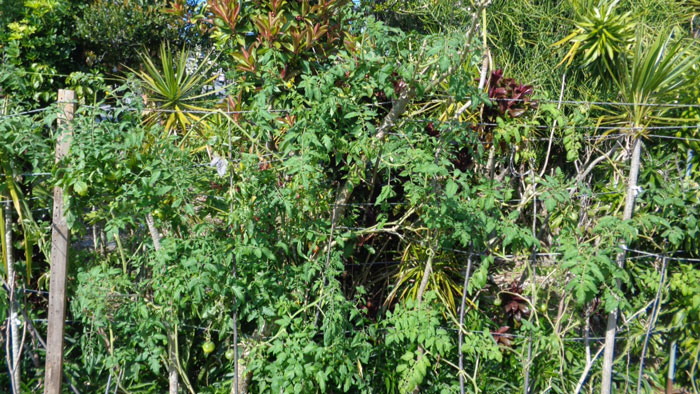
Photo #1: Tomatoes in the perennial grass biomass growing vigorously
In the last issue I explained about the no-till cultivation of tomatoes using EM. This site was formerly used as a parking lot, with coral limestone spread over a hard layer of heavy clay and compacted using a roller. The coral limestone at this location was crushed with a pickaxe, and the stones were removed to create ridges.
As a place to cultivate crops the soil here quite awful, but I have set up perennial grass biomass in five locations in a line (reference: No. 182 in this series, “Trial and Error at the Blue-Sky Palace, Part 2”). After the previous crop of bitter gourds were almost completely destroyed by Typhoon No. 6 in late August, I planted seedlings of commercially available 50-yen tomatoes (First Tomato) with pleasant results that have surprised visitors.
Tomatoes planted on perennial grass biomass did not decline in vigor and became stable, long-term plants with side branches appearing one after another after harvesting (Photo #1). On the other hand, tomatoes planted in between had weak regenerative power as well as fewer leaves and side branches (Photo #2 area circled in yellow).
I applied the same amount of EM fermented liquid, but the effect of the perennial grass biomass is outstanding. Based on this result, I applied EM Gravitron charcoal* in the same amount as I used in the perennial grass biomass to the base of the tomato plants planted in between. As shown in the center of Photo #2 (the area circled in red), this resulted in several healthy side branches sprouting from the base of the plant, and as shown in Photo #3, the plant has regained its vigor.
*EM Gravitron charcoal is an organic JAS-compliant EM rectified charcoal produced by the EM Gravitron carbonization system installed on the premises of Iwate Compost Co., Ltd.
I decided to make use of these healthy side branches as the main branches for long-term cultivation. From this row alone I harvested more than 600 tomatoes, which was a good result, and I am aiming to harvest 1,000 tomatoes for the second renewal season.
If things continue as they have, these will end toward the end of April, but if the plants continue to be vigorous, I would like to keep on growing until June, and possibly even into midsummer. I remove the aging leaves one after another and utilize them as bedding grass, and the sprouting method is used to renew new shoots without any trimming (Photo #4). As long as the tomatoes don’t get diseased or lack fertilizer, it is possible to make them perennial like fruit trees, so I am looking forward to the future.
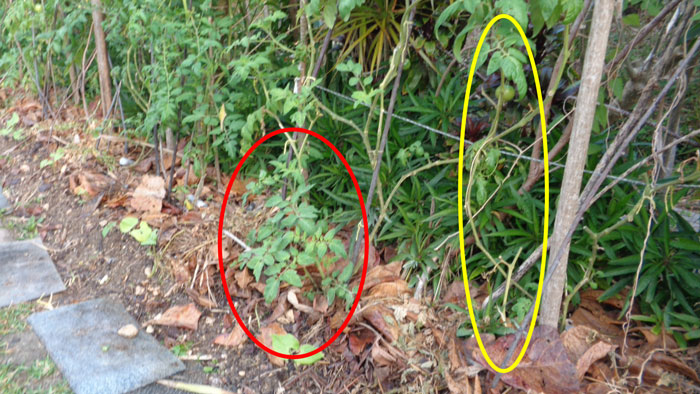
Photo #2: Tomatoes in areas not in perennial grass biomass are circled in yellow. There are fewer leaves and offshoots.
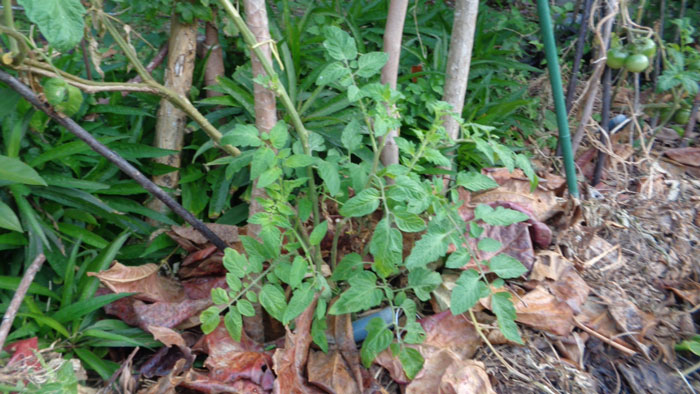
Photo #3: Offshoot branching of a tomato planted in a perennial grass biomass.
(This an enlarged photo from another angle of the area circled in red.)
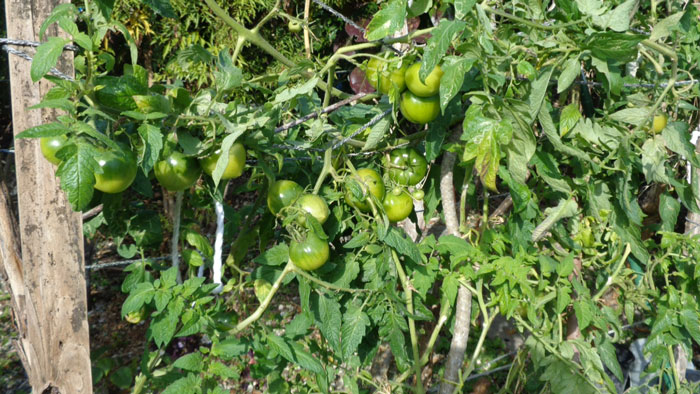
For fertilizer, I use fermented liquid fertilizer made from fermenting food waste and weeds with EM, and in order to increase the density of EM and improve its effectiveness, I only add about 0.2 to 0.5% of salt, rice bran and molasses. I use a method of continuous cultivation by adding materials as they decrease. Once or twice a week I apply 1 to 2 liters of the liquid fertilizer around the plants. (Reference: “No. 181 Trial and Error at the Blue Sky Palace”)
EM Research Organization, as well as many other research institutes around the world, are conducting research on the soil microbiota of EM. The conclusion reached is that “useful fluorescent actinomycetes increase and become more diverse with continued use of EM,” and it has become clear that it is very similar to the microbial flora of Terra Preta. In other words, continued use of EM will result in Terra Preta-like soil in a very short period of time, and EM Gravitron charcoal and barrier technology will, from the start, exceed this result (Reference: “Tell me! Mr. Shintani, tell us about EM rectified charcoal that is useful for creating Terra Preta and fermentation synthetic soils”)
It has also become clear that the continued use of EM in no-till cultivation and in combination with charcoal increases the number of phototrophic bacteria in the soil. At the same time, aerobic microorganisms begin to exist in the deeper layer below 30 centimeters and they are able to increase even in the hard clay layer, making the soil a microflora like a mass of microorganisms. We should be reminded that in the soil microbial quality and quantity contests not only in Japan but around the world, by far the best are soils that have been managed to increase EM through regular applications of EM.
Cosmos are in full bloom all over Okinawa. They last from late January to March. This type of scene was never seen in the past, but after the EM Graviton barrier (2014) was created, the soil has improved over the years, and now with ordinary management fruits are abundant and flowers are in full bloom.
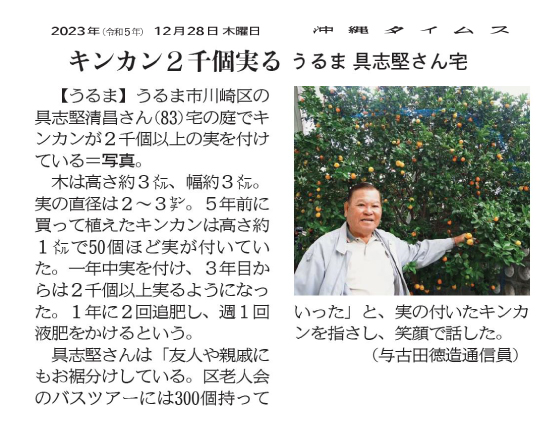
Okinawa Times, December 28, 2023
Photo shows a kumquat plant tree more than 2,000 fruits in the garden of Kiyomasa Gushiken (83) in Kawasaki-Ward, Uruma City.
The tree is about three meters tall and three meters wide. The diameter of the fruit is two to three centimeters. Mr. Gushiken bought and planted the tree five years ago, which at the time was about one meter tall and bore about fifty fruits. It bears fruit all year round and has produced more than 2,000 fruits annually since the third year. He fertilizes twice a year and applies liquid fertilizer weekly week. “I brought 300 kumquats with me on a bus tour organized by the senior citizens’ association of the ward,” Mr. Gushiken said, happily pointing to the kumquat-laden tree.
(Reported by Tokuzo Yokota)
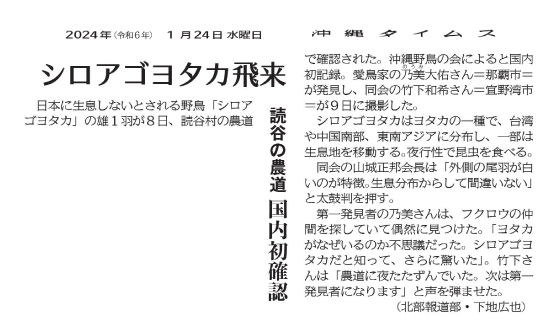
A Savanna Nightjar resting on a farm road in Yomitan Village on the 9th (photo by Kazuki Takeshita)
First confirmed sighting in Japan
Okinawa Times, January 24, 2024
On January 8th a male Savanna Nightjar, a wild bird believed to be non-indigenous in Japan, was spotted on a farm road in Yomitan Village. According to the Okinawa Wild Bird Society, this is the first record of the bird in Japan. It was discovered by bird enthusiast, Mr. Daisuke Noumi of Naha City, and photographed on the 9th by Mr. Kazuki Takeshita, a member of the same association in Ginowan City.
The Savanna Nightjar is a type of nightjar that is found in Taiwan, southern China, and Southeast Asia, with some of the birds migrating from one habitat to another. The birds are nocturnal and eat insects. Mr. Masakuni Yamashiro, chairman of the association, said, approvingly, “The white outer tail feathers are a distinctive feature. There is no doubt about it considering its habitat distribution.” Mr. Noumi, the first person to discover the bird, found it by chance while searching for a member of the owl family. “I wondered why a Grey Nightjar was here. I was even more surprised when I found out it was a Savanna Nightjar.” Mr. Takeshita said, “It was standing on a farm road at night. I hope I’ll be the first one to discover it the next time, too.”
(Hiroya Shimoji, Northern News Dept.)
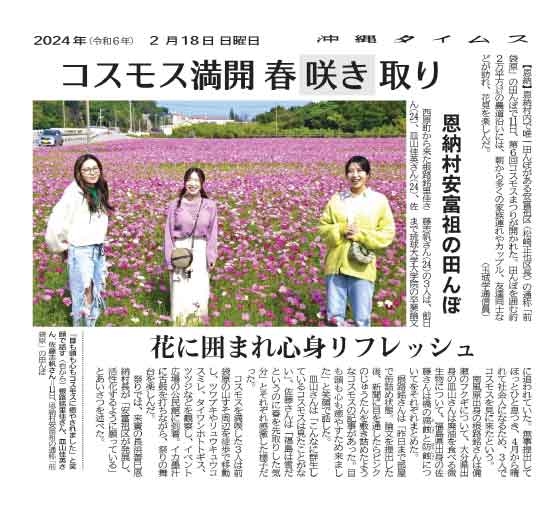
Photo: Rika Nejime, Yoshie Sarayama, and Shiho Sato (from the right) smiling and remarking on how the beautiful cosmos field provided a wonderful stress relief for their eyes, heads, and hearts. Taken at a rice field commonly known as Maebukurohara in Afuso, Onna Village on November 11th.
Rejuvenating the spirit and body surrounded by flowers
Rice field in Afuso in Onna Village
Okinawa Times, February 18, 2024
The 6th Cosmos Festival was held on the 11th in the rice field commonly known as “Maebukurohara” in Afuso Ward (Masaya Matsuzaki, ward head), which is the only rice field in Onna Village, Okinawa Prefecture. Many families, couples, and friends visited the field starting from morning and enjoyed viewing the cosmos blossoming along the approximately 20,000 square meter farm road that surrounds the rice fields. (Reported by Manabu Tamaki)
Three visitors, Rika Nejima (24), Yoshie Sarayama (24), and Shiho Sato (24), who came from Nishihara Town, had been busy working on their graduation thesis at University of the Ryukyus graduate school until the day before. They decided to take a break after successfully submitting their theses, and came to see the cosmos together before they start working in April.
In their theses Ms. Nejime, from Haebaru Town, wrote about Fukugi, the Happiness tree, in Bise, Ms. Sarayama, from Oita Prefecture, wrote about microorganisms that eat waste oil, and Ms. Sato from Fukushima Prefecture, wrote about corrosion and corrosion prevention of bridges.
Ms. Nejima said, “I was stuck in my room until yesterday. After submitting my thesis, I saw an article in the newspaper about cosmos that looked like pink carpet. I came here to soothe my eyes, head and heart,” she said with a smile.
Ms. Sarayama said, “I’ve never seen so many cosmos growing before,” and Ms. Sato added, “Even though it’s snowing in northern Japan, in Fukushima, I feel like it’s already spring here.”
After enjoying the cosmos blossoms, the three of them walked around the foot of the mountain in Maebukurohara, observing the Leopard Plant, Ryukyu small violets, Formosan violets, and azaleas, before arriving at the community center in the event plaza. They enjoyed the festival on stage while enjoy having squid ink soup. In a speech at the festival, the guest of honor, Yoshimi Nagahama, head of Onna Village, said he hopes that Afuso ward will “develop more and become more revitalized.”
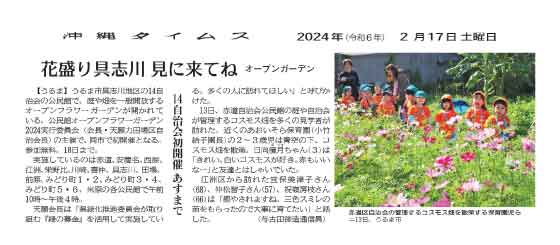
Photo: Nursery school children strolling in the cosmos field managed by the Akamichi-ward Community Association in Uruma City on March 13th.
An Open Garden event is being held at 14 neighborhood association community centers in the Gushikawa District of Uruma City, as they open their gardens and fields to the public. Sponsored by the Community Center Open Flower Garden 2024 Executive Committee (Chairman, Mr. Riki Tengan of Taba-ward community), this is the first such event to be held in the city. Entrance is free and the event lasts until the 18th.
This event is held at community centers in Akamichi, Agena, Nishihara, Esu, Enobi, Kawasaki, Kinaka, Gushikawa, Taba, Maebaru, Midori-cho 1 and 2, Midori-cho 3 and 4, Midori-cho 5 and 6, and Yonehara from 10 a.m. to 4 p.m.
Chairman Tengan said, “We are able to hold this event by utilizing the ‘Green Fundraising’ program of the Prefectural Green Promotion Committee. I’m really hoping that many people will visit.”
On the 13th, many visitors came to the garden at the Akamichi Community Center and the cosmos field managed by the community association. Two and three-year-old children from the nearby Aoi Sora Nursery School (Director, Yuko Otake) strolled through the cosmos field under the clear blue sky. Yuzuki Hyuga (3), excited to see all the flowers with her friends, said, “They are so beautiful. I like white cosmos. Red ones are nice, too.”
Mitsuko Gibo (68), Tomoko Nakamatsu (57), and Fusae Shukumine (66), who visited from Esu-ward, said, “Being surrounded by cosmos is so comforting and relaxing. We were given some three-colored cosmos seedlings, so we want to plant them and take good care of them.”
(Reported by Tokuzo Yokoda)
Read the original Japanese message at the link below.
2024.5.8 Updated.